TAVEUNI, FIJI – We’re on our way back from Rainbow Reef, heading for a dive site called Orgasmic, when we see the buoy.
There are three of us in the boat: me, and two Fijians. Jone (“Johnny”) is the lively, perpetually grinning divemaster at Susie’s Plantation — a rustic and welcoming resort down the west coast of the island, and my home away from home on Taveuni. Tevi, his cousin (everyone in Fiji seems to be everyone else’s cousin) is the sober pilot.
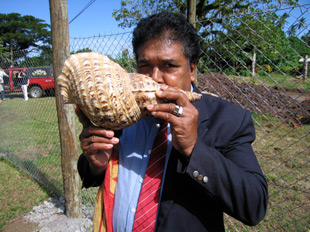
My Fijian companions are from Vuna, a 10-minute drive south of Susie’s. Vuna is the site of the Seacology project I’d come here to visit. Members of the village have agreed to preserve nearly 5,000 acres of forest, and to establish two marine no-take areas totaling 3,100 acres. In exchange, Seacology has built a kindergarten to serve the village children.
The ceremony took place a week before my Rainbow Reef dive, but it wasn’t the carefree occasion I witnessed in Viani (see my previous dispatch). Tuivuna – Vuna’s 82-year-old chief, and a hugely influential man in his day – is dying. According to Jone, he may have less than a month to live. When he passes, the traditional “100 Night” fishing tabu will be observed; lodge owners will have to meet with village leaders to determine if scuba diving or snorkeling will be allowed during that time.
At the ceremony I spoke with Mikaele Radrodro, a banker from Suva (Fiji’s capital) who helped broker the Seacology deal. With his red shirt, gold watch, and sunglasses perched on his closely cropped salt and pepper hair, he looked every inch the urbanized Fijian. In his estimation, the reefs are less an issue that the forests.
“The number of people moving inland is increasing,” he said. “They’re trying to find farmland, and they’re chopping down very large, old trees. If you look at the geology of Taveuni, this side is volcanic; the trees that have grown have protected the island from erosion. Cutting them would endanger not only the wildlife, but the population on this side of the island. There will be landslides and mudslides.”
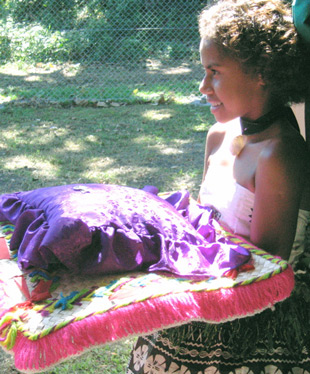
Part of the rationale for protecting the reef, Radrodro said, is to preserve the marine life for future generations. In particular, Vuna wants to limit the capture of sea turtles – still practiced in a neighboring village – to ceremonial occasions.
Another reason is that the protected site is prime real estate for a resort. “We’re doing this in order to have some power and influence if developers seek permission to build.”
How, I asked, will the protected reef areas be marked, and how will they be patrolled? This was a sticking point in Viani – and it’s a sticking point here.
“Right now it’s hard to say, because we don’t have a system. But we do have matanivanua: the right-hand men of the chief. We’ve asked them to keep a watch on the area.”
“And how will the boundaries of the no-take zone be made known?”
“Very true,” Radrodro replied apologetically. “Right now we don’t have anything in place. All we can do is put it in the media, and maybe have a relationship with the wildlife Fiji — an organization that looks after the sea resources and forest reserves.
“But there is a communal understanding to protect this area,” he continued. “The village elders are here. Anybody intervening will be reported straight to these people, and then to the police.”
* * *
Many divers consider the reefs ringing Taveuni to be the best in Fiji, even lovelier than the corals in the protected marine reserve of Namena, off Vanua Levu (I promise to stop using so many proper nouns after this paragraph).
Typically, however, I find myself in Taveuni during a record-breaking cold snap. June is the southern hemisphere’s winter; and though the Fijian islands lie only 15 degrees below the equator, a cold front has blown up from New Zealand. Days have been gray, with rain clouds anchored on Taveuni’s volcanic peaks; at night it pours torrentially, often with high winds.
But the water is warm, and visibility is excellent. Today is the first day the winds have allowed us to visit Rainbow Reef, the island’s most famous dive site. On our way out we spy a small pod of pilot whales, moving south – a common sight in these waters.
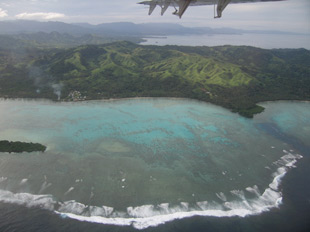
After a 30-minute journey we moor at a site called White Wall, and prepared for a “drift” dive. Jone and I drop in, descend, and let the current carry us past the corals.
We drift along at a speed of about two knots, our bodies parallel in the clear water. The our right lies the deep sea, descending to more than 5,000′. To our left is the White Wall itself: a steep and seemingly endless cliff, covered with billowing plumes of white soft corals. I’ve never seen anything like it. Moving effortlessly through the water, with Jone beside me, I imagine we are superheroes – flying in slow motion along the flanks of a snow-covered mountain range.
* * *
When we climb back on the dive boat, an hour later, the wind has changed. Staying out by Rainbow Reef is not advisable. But the tides are right, Jone says, for a dive at Orgasmic: the best site to see hammerhead sharks, rays, and sea turtles.
Orgasmic is in the opposite direction, back to the south, past our starting point at Susie’s. The best way to get there from the White Wall is a straight line: down the middle of the broad channel that separates the islands of Taveuni and Vanua Levu.
It’s in that channel, about five miles off the coast of Taveuni, that we spy the buoy: a bright orange buoy, hard plastic, bobbing in the sea. Tevi slows the boat, and we bob along beside it.
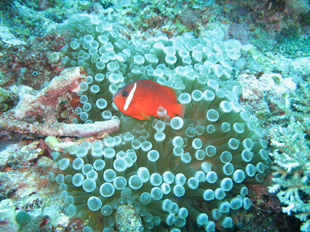
The divemaster and boatman look at each other, and start talking in rapid Fijian. After a few minutes Jone turns to me.
“It’s part of a long line,” he says quietly.
I’d never even heard of long lines until the previous week, during my visit to Vanua Levu. They work like this: nylon ropes, sometimes weighted, are suspended from widely-spaced buoys. Under the water, connected to these drop lines, are cross cords — imagine long clotheslines, suspended between apartment buildings (all underwater, of course). From those cords hang individual fishing lines, each one ending in a stainless steel hook and baited with a small fish.
The assembled long line is a virtual curtain of hooks, hanging 20-30 feet down, tempting any creature that swims by. The hooks are even sleeved in fluorescent plastic, to attract fish at dusk.
“We call it the ‘Wall of Death,'” says Jone.
I’m unclear what is meant by the word “long,” imagining the lines to be perhaps 1,000 feet from end to end.
“This line alone,” Jone informs me, “might be 300 miles long – it runs the entire length of the Fijian islands.”
“So what are we going to do?”
“It’s up to you,” says Jone. “We’re supposed to take you diving. That’s our job. But if we were out here alone, we’d pull up the buoy — and as much of the long line as possible.”
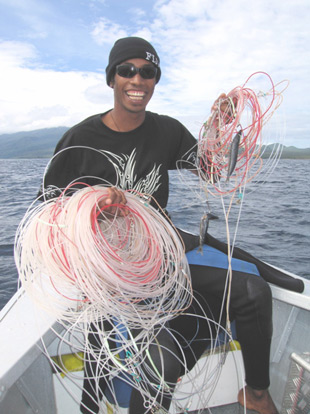
Five minutes later, the orange buoy is in the boat. Tevi radios the base at Susie’s, and a second boat comes to join us. They quickly find a second buoy, and haul it up.
“They are trying to catch yellowfin and bluefin tuna, bonita, even marlin,” Jone explains. “But they catch everything that comes along: dolphins, rays, turtles, everything. When they catch a shark they just cut off the fin, and throw the rest back in.”
I remember the pilot whales, moving south. The thought of one of those creatures caught on these hooks makes me sick.
With the buoys onboard, we begin pulling the drop lines from the sea. It’s not hard work, but it’s tedious. The ropes gives way to thick, smelly monofilament, and an elaborate system of connectors, knots, and baited hooks. Jone removes the bait fish – each about 4″ long – and throws them overboard. Within 10 minutes there are thick coils of line on the floor of our boat; after half an hour they take up more room than our dive tanks. Trying to recover the entire line is futile, so we cut the monofilament and let it drop into the water. Jone frowns; chances are good that sections of the line will drift toward shore, and become entangled in Taveuni’s reefs.
According to Fijian law, villagers maintain exclusive fishing rights for a distance of 10 miles off their coasts. It is illegal for outsiders to drop lines of any kind within those limits. The lines we’re pulling in – destroying hundreds of dollars worth of equipment – are only five miles offshore.
“I don’t understand,” I remark to Jone, “why the fishing boats don’t just stick to the 10-mile limit.”
“Because the fish stay closer to the islands,” he says, “where the reefs are.”
But there’s a more obvious reason, which somehow escaped my logic. The line may be 300 miles long, but some of those miles pass through the channels between islands – and those gaps aren’t 20 miles wide. No matter where the line is laid, in other words, it’s within 10 miles of an island.
Naively enough, I’m astonished by this flagrant flouting of the law. “Isn’t the Government of Fiji able to do something about this?”
“The Government of Fiji gave them the permit,” Tevi says sourly.
* * *
There are shouts of glee when we find a third buoy. Rising beside it is a bobbing pole. Attached to the pole with duct tape is a beacon, to help the trawler find its catch. Neither Jone nor Tevi know how to turn off the beacon, so they call their cousin, Boi, off the other boat. Boi once worked on a long line ship, but he has reformed, and is as passionate about the mission as the rest of his clan.
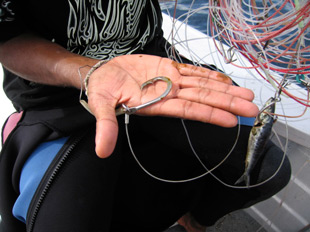
He explains how the trawlers motor through the straights all night, laying the line from enormous spools in their holds. A day or two later they return, reeling in the lines and dumping their catch into huge coolers.
“I hate these damned things,” Boi says, turning off the beacon and pulling the buoy into the boat. He eyes the orange sphere slyly. “We’ll cut that in half,” he says, “and drink kava out of it tonight.”
“What will happen” I ask, “when they come looking for their stuff?”
“When they come to look for it,” Tevi growls, “Tell them to look for me.”
“That’s why there’s not so many fish to see diving,” adds Jone. “They’re all on the long lines – or in tins, in the shops.”
* * *
That night around eight, after an outdoor dinner of curry chicken at Susie’s, Jone spies a bright light on the horizon. It’s the fishing trawler, come back to retrieve its line. Jone, Tevi and I stand on the grassy cliff overlooking the ocean, watching with satisfaction as the ship makes futile circles. Its spotlight rakes the water with impotent strokes, flaring beneath the stars.
We’re gloating, but it’s a hollow victory. We destroyed about one percent of the long line, on one occasion. It is not difficult to imagine just how quickly these poachers will decimate the population of these waters, despite the best efforts of superheroes like Tevi, Jone and Boi.
“This is the problem,” says Jone, nodding his head. “It doesn’t matter which areas are protected. If the government continue to allow long lines, there won’t be any fish.”
* * *
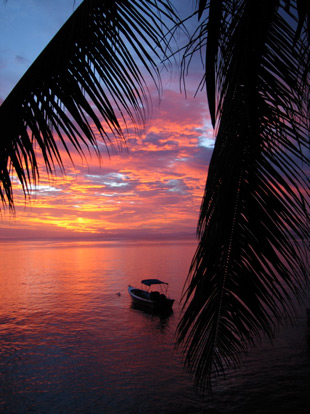
The next morning is spectacular, sunny and gorgeous, the sea calm, the fronds of the coconut palms barely stirring. All over Fiji, at scores of dive centers, people are preparing to enjoy the first great diving day in a week.
Everywhere, that is, but here. At two this morning, Tuivuna, the beloved Chief of Vuna, died from his long-ago injury. He was 82 years old; now the negotiations to pick his successor will begin in earnest. Both Jone and Tevi must spend the day in Vuna, communing with their relatives. Diving will resume tomorrow: the day I fly back to America. But for the next 100 days and nights, the fish of Vanu reef will be left at peace.
* * *
Epilogue: Tuivuna, sadly, did not live to hear the postscript to this story. I just heard it myself, nearly two weeks after the events described above, in an email from an American woman living on the island of Vanua Levu. She had this to say:
“It looks as though Greenpeace in Fiji is turning their attention to foreign fishing vessels depleting Fijian fish stocks. The office in Suva has a banner across their balcony that reads, “Fiji’s fish are being stolen!” Also, a senator made a presentation regarding fishing sustainability and poaching in session on Friday, July 7th.”
If there’s one thing I’ve learned during my island investigations, it’s this: good intentions can be backed up with good laws; but good laws are only as good as their enforcement. When the government will not enforce the law, and the villagers cannot, outside groups are sometimes the only answer.
Eventually, Seacology may be able to provide patrol boats to Vuna. Until that time comes, I welcome Greenpeace’s intentions. They have the resources – and the moxy – to finish the job that Jone, Tevi and Boi started: making long line fishing a losing proposition. That may the only way, for now, to keep foreign fishing factories out of protected Fijian waters.
Read Ethical Traveler's Reprint Policy.
